 | |||||||||||||||||||||||||||||||||||||||||||||||||||||||||||||
| Tanakh (Judaism) | |||||||||||||||||||||||||||||||||||||||||||||||||||||||||||||
|---|---|---|---|---|---|---|---|---|---|---|---|---|---|---|---|---|---|---|---|---|---|---|---|---|---|---|---|---|---|---|---|---|---|---|---|---|---|---|---|---|---|---|---|---|---|---|---|---|---|---|---|---|---|---|---|---|---|---|---|---|---|
|
|||||||||||||||||||||||||||||||||||||||||||||||||||||||||||||
| Old Testament (Christianity) | |||||||||||||||||||||||||||||||||||||||||||||||||||||||||||||
|
|||||||||||||||||||||||||||||||||||||||||||||||||||||||||||||
| Bible portal | |||||||||||||||||||||||||||||||||||||||||||||||||||||||||||||

The Book of Tobit (/ˈtoʊbɪt/) is an apocryphal Jewish work from the 3rd or early 2nd century BCE which describes how God tests the faithful, responds to prayers, and protects the covenant community (i.e., the Israelites). It tells the story of two Israelite families, that of the blind Tobit in Nineveh and of the abandoned Sarah in Ecbatana. Tobit's son Tobias is sent to retrieve ten silver talents that Tobit once left in Rhages, a town in Media. Guided and aided by the angel Raphael he arrives in Ecbatana, where he meets Sarah. A demon named Asmodeus kills anyone she intends to marry, but with the aid of Raphael the demon is exorcised and Tobias and Sarah marry. Tobias and Sarah then return to Nineveh, where Tobit is cured of his blindness.
The book is included in the Catholic and Eastern Orthodox canons and the Dead Sea Scrolls, but not in the Jewish Masoretic text. Protestant tradition places it in the Apocrypha, with Anabaptists, Lutherans, Anglicans and Methodists recognising it as useful for purposes of edification and liturgy, albeit non-canonical in status.
The vast majority of modern commentators recognize it as a work of fiction with some references to historical events. The story is set in the 8th century BC, but the book itself is thought to date from between 225 and 175 BC. No scholarly consensus exists on the place of composition, but a Mesopotamian origin seems logical given that the story takes place in Assyria and Persia and it mentions the Persian demon "aeshma daeva", rendered "Asmodeus". However, the story contains significant errors in geographical detail (such as the distance from Ecbatana to Rhages and their topography), and arguments against and in favor of Judean or Egyptian composition also exist.
Structure and summary

The book has 14 chapters, forming three major narrative sections framed by a prologue and epilogue:
- Prologue (1:1–2)
- Situation in Nineveh and Ecbatana (1:3–3:17)
- Tobias's journey (4:1–12:22)
- Tobit's song of praise and his death (13:1–14:2)
- Epilogue (14:3–15)
(Summarised from Benedikt Otzen, "Tobit and Judith").
The prologue tells the reader that this is the story of Tobit of the tribe of Naphtali, deported from Tishbe in Galilee to Nineveh by the Assyrians. He has always kept the laws of Moses, and brought offerings to the Temple in Jerusalem before the catastrophe of the Assyrian conquest. The narrative highlights his marriage to Anna, and they have a son named Tobias.
Tobit, a pious man, buries dead Israelites, but one evening while he sleeps he is partially blinded by a bird which defecates in his eyes; he later becomes fully blind after physicians place ointment in his eyes. He becomes dependent on his wife, but accuses her of stealing and prays for death. Meanwhile, his relative Sarah, living in far-off Ecbatana, also prays for death, for the demon Asmodeus has killed her suitors on their wedding nights and she is accused of having caused their deaths.
God hears their prayers and the archangel Raphael is sent to help them. Tobias is sent to recover money from a relative, and Raphael, in human disguise, offers to accompany him. On the way they catch a fish in the Tigris, and Raphael tells Tobias that the burnt heart and liver can drive out demons and the gall can cure blindness. They arrive in Ecbatana and meet Sarah, and as Raphael has predicted the demon is driven out.
Tobias and Sarah are married, Tobias grows wealthy, and they return to Nineveh (Assyria) where Tobit and Anna await them. Tobit's blindness is cured, and Raphael departs after admonishing Tobit and Tobias to bless God and declare his deeds to the people (the Israelites), to pray and fast, and to give alms. Tobit praises God, who has punished his people with exile but will show them mercy and rebuild the Temple if they turn to him.
In the epilogue Tobit tells Tobias that Nineveh will be destroyed as an example of wickedness; likewise Israel will be rendered desolate and the Temple will be destroyed, but Israel and the Temple will be restored; therefore Tobias should leave Nineveh, and he and his children should live in righteousness.
Significance
Tobit is a work with some historical references, combining prayers, ethical exhortation, humour and adventure with elements drawn from folklore, wisdom tale, travel story, romance and comedy. It offered the diaspora (the Jews in exile) guidance on how to retain Jewish identity, and its message was that God tests his people's faith, hears their prayers, and redeems the covenant community (i.e., the Jews).
Readings from the book are used in the Latin liturgical rites of the Catholic Church. Because of the book's praise for the purity of marriage, it is often read during weddings in many rites. Doctrinally, the book is cited for its teachings on the intercession of angels, filial piety, tithing and almsgiving, and reverence for the dead. Tobit is also made reference to in chapter 5 of 1 Meqabyan, a book considered canonical in the Ethiopian Orthodox Tewahedo Church.
Composition and manuscripts

Tobit exists in two Greek versions, one (Sinaiticus) longer than the other (Vaticanus and Alexandrinus). Aramaic and Hebrew fragments of Tobit (four Aramaic, one Hebrew – it is not clear which was the original language) found among the Dead Sea Scrolls at Qumran tend to align more closely with the longer or Sinaiticus version, which has formed the basis of most English translations in recent times.
The Vulgate places Tobit, Judith and Esther after the historical books (after Nehemiah). Some manuscripts of the Greek version place them after the wisdom writings.
Canonical status
Those books found in the Septuagint, but not in the Masoretic text are called the deuterocanon, meaning "second canon". Catholic and Orthodox Christianity include it in the Biblical canon. As Protestants came to follow the Masoretic canon, they therefore did not include Tobit in their canon, but do recognise it in the category of deuterocanonical books called the apocrypha.
The Book of Tobit is listed as a canonical book by the Council of Rome (AD 382), the Council of Hippo (AD 393), the Council of Carthage (397) and (AD 419), the Council of Florence (1442) and finally the Council of Trent (1546), and is part of the canon of both the Catholic Church and Eastern Orthodox Churches. Catholics refer to it as deuterocanonical.
Augustine (c. AD 397) and Pope Innocent I (AD 405) affirmed Tobit as part of the Old Testament Canon. Athanasius (AD 367) mentioned that certain other books, including the book of Tobit, while not being part of the Canon, "were appointed by the Fathers to be read".
According to Rufinus of Aquileia (c. AD 400) the book of Tobit and other deuterocanonical books were not called Canonical but Ecclesiastical books.
Protestant traditions place the book of Tobit in an intertestamental section called Apocrypha. In Anabaptism, the book of Tobit is quoted liturgically during Amish weddings, with "the book of Tobit as the basis for the wedding sermon." The Luther Bible holds Tobit as part of the "Apocrypha, that is, books which are not held equal to the sacred Scriptures, and nevertheless are useful to read". Luther's personal view was that even if it were "all made up, then it is indeed a very beautiful, wholesome and useful fiction or drama by a gifted poet" and that "this book is useful and good for us Christians to read." Article VI of the Thirty-Nine Articles of the Church of England lists it as a book of the "Apocrypha". The first Methodist liturgical book, The Sunday Service of the Methodists, employs verses from Tobit in the Eucharistic liturgy. Scripture readings from the Apocrypha are included in the lectionaries of the Lutheran Churches and the Anglican Churches, among other denominations using the Revised Common Lectionary, though alternate Old Testament readings are provided. Liturgically, the Catholic and Anglican churches may use a scripture reading from the Book of Tobit in services of Holy Matrimony.
Tobit contains some interesting evidence of the early evolution of the canon, referring to two rather than three divisions, the Law of Moses (i.e. the torah) and the prophets. For unknown reasons it is not included in the Masoretic text of the Hebrew Bible, although four Aramaic and one Hebrew fragment were found among the Dead Sea Scrolls, indicating an authoritative status among some sects. Proposed explanations have included its age, literary quality, a supposed Samaritan origin, or an infringement of ritual law, in that it depicts the marriage contract between Tobias and his bride as written by her father rather than her groom. Alternatively, allusions to fallen angels and its thematic connections with works such as 1 Enoch and Jubilees may have disqualified it from canonicity. It is, however, found in the Greek text of the Septuagint, from which it was adopted into the Christian canon by the end of the 4th century.
Influence
Tobit's place in the Christian canon allowed it to influence theology, art and culture in Europe. It was often dealt with by the early Church fathers, and the motif of Tobias and the fish (the fish being a symbol of Christ) was extremely popular in both art and theology; this is normally called Tobias and the Angel in art. Particularly noteworthy in this connection are the works of Rembrandt, who, despite belonging to the Dutch Reformed Church, was responsible for a series of paintings and drawings illustrating episodes from the book.
Scholarship on folkloristics (for instance, Stith Thompson, Dov Noy, Heda Jason and Gédeon Huet) recognizes the Book of Tobit as containing an early incarnation of the story of The Grateful Dead, albeit with an angel as the hero's helper, instead of the spirit of a dead man.
The story of Tobit inspired also the oratorio Il ritorno di Tobia (1775) by Joseph Haydn.
Image gallery
-
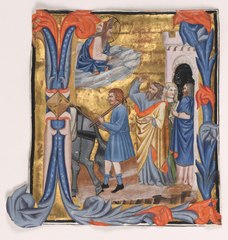 Departure of Tobias guided by the archangel Raphael; cutting from an initial I from a gradual by the Master of Noah's Ark: Cleveland Museum of Art
Departure of Tobias guided by the archangel Raphael; cutting from an initial I from a gradual by the Master of Noah's Ark: Cleveland Museum of Art
-
 Tobias heals the blindness of his father Tobit, by Domingos Sequeira
Tobias heals the blindness of his father Tobit, by Domingos Sequeira
-
 Illumination with Tobit, Tobias, and the archangel Raphael in an initial O. (14th century AD)
Illumination with Tobit, Tobias, and the archangel Raphael in an initial O. (14th century AD)
-
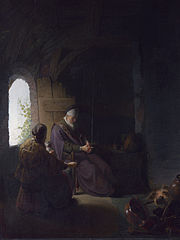 Anna and the Blind Tobit, Rembrandt and Dou (1630)
Anna and the Blind Tobit, Rembrandt and Dou (1630)
-
 Tobias and the Angel, Filippino Lippi, c. 1472–1482
Tobias and the Angel, Filippino Lippi, c. 1472–1482
-
 The wedding of Tobias and Sarah: Raphael binds the demon. Jan Steen, c. 1660
The wedding of Tobias and Sarah: Raphael binds the demon. Jan Steen, c. 1660
-
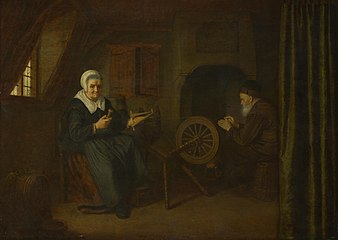 Tobit and Anna, Abraham De Pape, c. 1658 National Gallery of London
Tobit and Anna, Abraham De Pape, c. 1658 National Gallery of London
-
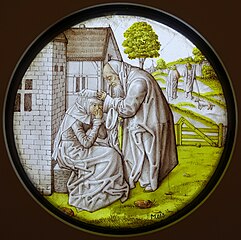 Tobit comforts Anna, stained glass roundel, southern Netherlands, c. 1500
Tobit comforts Anna, stained glass roundel, southern Netherlands, c. 1500
-
 Tobit buries the dead, F. Bartolozzi after G.B. Castiglione, 1651.
Tobit buries the dead, F. Bartolozzi after G.B. Castiglione, 1651.
-
 The Blindness of Tobit: A Sketch, William James Smith, After Rembrandt, ca. 1825.
The Blindness of Tobit: A Sketch, William James Smith, After Rembrandt, ca. 1825.
See also
- Mary Untier of Knots (painting with Tobias and the Angel)
- Tobias and the Angel (Verrocchio)
- Philosopher in Meditation ("Tobit and Anna in an Interior" by Rembrandt)
Notes
- From the Ancient Greek: Τωβίθ Tōbith or Τωβίτ Tōbit (Τωβείθ and Τωβείτ spellings are also attested) itself from Hebrew: טובי Tovi "my good"; Book of Tobias in the Vulgate from the Greek Τωβίας Tōbias, itself from the Hebrew טוביה Tovyah "Yah is good"
- Also known as the Book of Tobias.
References
Citations
- ^ Levine 2007, p. 11.
- ^ Fitzmyer 2013, p. 31.
- ^ Geisler, Norman L.; MacKenzie, Ralph E. (1995). Roman Catholics and Evangelicals: Agreements and Differences. Baker Publishing Group. p. 171. ISBN 978-0-8010-3875-4.
Lutherans and Anglicans used it only for ethical / devotional matters but did not consider it authoritative in matters of faith.
- ^ John Wesley (1825). The Sunday Service of the Methodists; With Other Occasional Services. J. Kershaw. p. 136.
- ^ Dyck, Cornelius J.; Martin, Dennis D. (1955). The Mennonite Encyclopedia: A-C. Mennonite Brethren Publishing House. p. 136. ISBN 978-0-8361-1119-4.
- ^ Kirwan, Peter (16 April 2015). Shakespeare and the Idea of Apocrypha: Negotiating the Boundaries of the Dramatic Canon. Cambridge University Press. p. 207. ISBN 978-1-316-30053-4.
- ^ Fitzmyer 2003, p. 31.
- Fitzmyer 2003, p. 51.
- Miller 2011, p. 12-15.
- Fitzmyer 2013, p. 58.
- Otzen 2002, p. 4-7.
- Tobit 2:7-10
- ^ Levine 2007, p. 12.
- "Introduction", Tobit, NAB, Libreria Editrice Vaticana Archived February 27, 2015, at the Wayback Machine
- Chisholm, Hugh, ed. (1911). "Tobit, The Book of" . Encyclopædia Britannica. Vol. 26 (11th ed.). Cambridge University Press. pp. 1041–1042.
- "Torah of Yeshuah: Book of Meqabyan I – III". Archived from the original on 2019-09-23. Retrieved 2019-11-10.
- ^ Grabbe 2003, p. 736.
- Jerusalem Bible (1966), "Introduction to Tobit, Judith and Esther", p. 601
- ^ Nigosian 2004, p. 197.
- "Tertullian : Decretum Gelasianum (English translation)". Archived from the original on 2017-11-19. Retrieved 2016-10-19.
- "Canon XXIV. (Greek xxvii.)", The Canons of the 217 Blessed Fathers who assembled at Carthage, Christian Classics Ethereal Library, archived from the original on 2016-08-26, retrieved 2016-10-19
- B. F. Westcott, A General Survey of the History of the Canon of the New Testament (5th ed. Edinburgh, 1881), pp. 440, 541–2.
- "Council of Carthage (A.D. 419) Canon 24". Archived from the original on 2016-12-16. Retrieved 2016-10-19.
- Eccumenical Council of Florence and Council of Basel Session 11—4 February 1442. ewtn. Archived from the original on 7 May 2019. Retrieved 20 October 2016.
- "Session IV Celebrated on the eighth day of April, 1546 under Pope Paul III". Archived from the original on 2015-03-23. Retrieved 2016-10-20.
- Fitzmyer, at p. 50, 55–57
- of Hippo, Augustine. On Christian Doctrine Book II Chapter 8:2. newadvent. Archived from the original on 16 July 2016. Retrieved 12 October 2016.
- Westcott, Brooke Foss (2005). A general survey of the history of the canon of the New Testament Page 570 (6th ed.). Eugene, Oregon: Wipf & Stock. ISBN 1597522392.
- of Alexandria, Athanasius. CHURCH FATHERS: Letter 39 (Athanasius). newadvent. Archived from the original on 21 November 2016. Retrieved 14 October 2016.
- of Aquileia, Rufinus. Commentary on the Apostles' Creed #38. newadvent. Archived from the original on 11 January 2017. Retrieved 12 October 2016.
- "Anglican Articles of Religion". Anglicansonline.org. 2007-04-15. Archived from the original on 2007-07-01. Retrieved 2014-03-11.
- Readings from the Apocrypha. Forward Movement Publications. 1981. p. 5.
- "The Revised Common Lectionary" (PDF). Consultation on Common Texts. 1992. Archived from the original (PDF) on 1 July 2015. Retrieved 19 August 2015.
In all places where a reading from the deuterocanonical books (The Apocrypha) is listed, an alternate reading from the canonical Scriptures has also been provided.
- DeSilva, David Arthur (2002). Introducing the Apocrypha: Message, Context, and Significance. Baker Academic. p. 76. ISBN 978-0-8010-2319-4.
The author also promotes an ideology of marriage, revealed mainly in the prayer of 8:5–7 (which is an optional Old Testament reading in Catholic, Anglican, and United Methodist marriage services).
- Dempster 2008, p. unpaginated.
- Klawans, Jonathan (2020). The Jewish Annotated Apocrypha. Oxford University Press. pp. 149–151. ISBN 978-0-19-026248-8.
- ^ Fitzmyer 2003, p. 55.
- Klawans 2020, p. 150.
- ^ Otzen 2002, p. 65-66.
- Laura A. Hibbard, Medieval Romance in England p. 74. New York Burt Franklin, 1963.
- Huet, G. "LE CONTE DU « MORT RECONNAISSANT » ET LE LIVRE DE TOBIE." Revue De L'histoire Des Religions 71 (1915): 1-29. Accessed June 18, 2020. www.jstor.org/stable/23662846.
- Jason, Heda. "Study of Israelite and Jewish Oral and Folk Literature: Problems and Issues". In: Asian Folklore Studies 49, no. 1 (1990): 88. Accessed May 18, 2021. doi:10.2307/1177950.
- Thompson, Stith (1977). The Folktale. University of California Press. p. 52. ISBN 0-520-03537-2.
- Noy, Dov. Folktales of Israel. University of Chicago Press. 1963. p. 126.
Works cited
- Dempster, Stephen G. (2008). "Torah, Torah, Torah: The Emergence of the Tripartite Canon". In Evans, Craig A.; Tov, Emanuel (eds.). Exploring the Origins of the Bible. Baker Academic. ISBN 9781585588145.
- Fitzmyer, Joseph A. (2013). Tobit. Walter de Gruyter. ISBN 9783110907032.
- Fitzmyer, Joseph A. (2003). Tobit. Walter de Gruyter. ISBN 9783110175745.
- Grabbe, Lester (2003). "Tobit". In Dunn, James D. G. (ed.). Eerdmans Commentary on the Bible. Eerdmans. ISBN 9780802837110.
- Levine, Amy-Jill (2007). "Tobit". In Coogan, Michael David (ed.). The New Oxford Annotated Apocrypha. Oxford University Press. ISBN 9780195288803.
- Miller, Geoffrey David (2011). Marriage in the Book of Tobit. Walter de Gruyter. ISBN 9783110247862.
- Nigosian, S. A. (2004). From Ancient Writings to Sacred Texts: The Old Testament and Apocrypha. Johns Hopkins University Press. ISBN 9780801879883.
- Otzen, Benedikt (2002). Tobit and Judith. A&C Black. ISBN 9780826460530.
Further reading
- Barker, Margaret (2006). "The Angel Raphael in the Book of Tobit". In Bredin, Mark (ed.). Studies in the Book of Tobit. A&C Black. ISBN 9780567082299.
External links
- Book of Tobit in Hebrew and English, from Sefaria
- Book of Tobit from St. Takla Haymanot's Coptic Orthodox website in English (also available in Arabic)
- Milbank, Alison; Talbert, Andrew (2010). "Tobit". Bibledex: Deuterocanonical Books. Brady Haran for the University of Nottingham.
 Tobit public domain audiobook at LibriVox Various versions
Tobit public domain audiobook at LibriVox Various versions- "Tobit, Book of" . New International Encyclopedia. 1905.
| Deuterocanon / Apocrypha | ||
|---|---|---|
| Preceded byNehemiah | R. Catholic Books of the Bible |
Succeeded byJudith |
| Preceded byEzra–Nehemiah (2 Esdras) |
Eastern Orthodox Books of the Bible | |
| Book of Tobit | |||||||
|---|---|---|---|---|---|---|---|
| Book of Tobit | |||||||
| People |
| 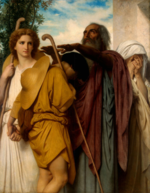 | |||||
| Places | |||||||
| Portrayals in media |
| ||||||
| Related | |||||||
| Sources | |||||||
| Jewish apocrypha | |
|---|---|
| Apocrypha in the Torah | |
| Apocrypha in Nevi'im | |
| Apocrypha in Ketuvim | |
| Other apocrypha | |
| Books of the Bible | |||||||||||||||
|---|---|---|---|---|---|---|---|---|---|---|---|---|---|---|---|
| Old Testament |
| ||||||||||||||
| New Testament |
| ||||||||||||||
| Subdivisions | |||||||||||||||
| Development | |||||||||||||||
| Manuscripts | |||||||||||||||
| Related | |||||||||||||||